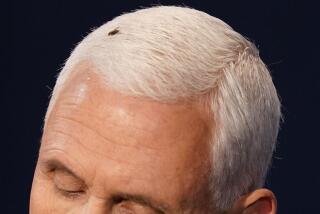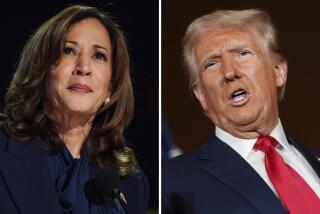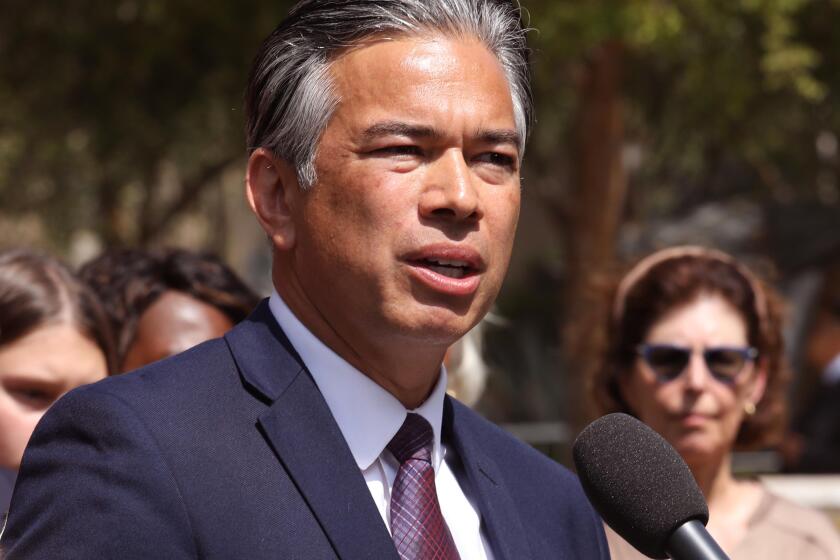COLUMN ONE : Quayle: He Tries Harder : The vice president has been a loyal adviser and effective fund-raiser while keeping a low profile. Now, he seems to hope media attacks can be turned to his advantage.
- Share via
WASHINGTON — When Vice President Dan Quayle’s Air Force plane set down at Trenton, N. J., airport last month, a local reporter rudely asked him: “Why do you keep coming to New Jersey when you are not any more popular here than (Democratic Gov.) Jim Florio?”
But, less than an hour later, Quayle strode into a GOP fund-raising dinner in that same city and received a two-minute standing ovation from a sellout crowd of Republican regulars. His appearance that night helped to raise $250,000 for the New Jersey Republican Party.
The incident, recounted often lately by Quayle’s admirers, captures the frustration that the 44-year-old vice president has been feeling these days as he tries to convince the American public that he has been improperly portrayed as a political lightweight.
By all accounts, Quayle has acquitted himself admirably as vice president. He has been a loyal adviser at the White House, an effective partisan on the stump, a competent diplomat on foreign assignments and a persuasive advocate on Capitol Hill.
The trouble is, few people have been paying much attention.
Until President Bush’s hospitalization earlier this week thrust Quayle back into the limelight, the vice president has seldom been perceived as more than a smiling face in the background at White House ceremonies--or the butt of jokes on the Johnny Carson show.
As a result, even though Quayle has tried hard to prove he is capable of taking the reins if anything happens to Bush, polls show that Americans have no more confidence in him now than they did after his bumbling campaign in 1988.
In a nutshell, Quayle has shown that he can be a diligent vice president, but he has not convinced the many skeptics--including many in his own party--that he has the depth of character or leadership skills to become President.
“The public-opinion needle on Dan Quayle has been stuck on 1988,” said Stephen Hess, political analyst at the Brookings Institution. “There is no question that the American people are still ill at ease about having him as vice president.”
As vice president, Quayle has been no less energetic than any of his predecessors. Even the indefatigable Hubert H. Humphrey, who served under President Lyndon B. Johnson, did not normally maintain a more rigorous vice presidential schedule than Quayle.
Quayle has visited 46 states and 31 countries, raised $17 million for Republican candidates and conscientiously carried out presidential mandates to supervise panels appointed to help craft the Administration’s approach to regulation and space policy.
And, although Quayle recently infuriated some liberal Democrats by scuttling clean air regulations proposed by the Environmental Protection Agency, his performance seems to have made him more friends than enemies.
He has also frequently helped to placate right-wing Republicans when they have been upset by Bush’s policies.
Clearly, Quayle’s work has been good enough to win him the respect of his boss.
“I see him in action--I know what he’s doing,” Bush told reporters on Wednesday. “And I can’t ask any more of him . . . . I think he’s getting a bum rap in the press.”
Unfortunately for Quayle, however, all that has not earned him much respect outside of Washington. Ironically, although the vice presidency exists only to provide a successor to the President, it does not permit a politician much leeway to demonstrate his leadership capabilities.
Furthermore, Quayle has adopted such a cautious, low-key public relations strategy--a game plan designed primarily to avoid any serious gaffes--that he has even less opportunity than most vice presidents to make a reputation for himself apart from that of the President.
No one knows such problems better than Bush, who, during eight years in the shadow of President Ronald Reagan, was unable to shed his own image as a “wimp.” That may be why Bush seems so sympathetic to Quayle--and repeatedly denies that he may choose another running mate.
When the two men talked privately about the problem on Tuesday, Bush said later, he advised Quayle: “Look, keep your head up. You’re talking to a guy that went through something like this for about eight years--maybe not quite as intense, but this goes with the territory.”
Nor is Quayle the first Veep to see his qualifications for higher office questioned. President Franklin D. Roosevelt chose Harry S. Truman to replace Henry A. Wallace after his third term. And President Gerald R. Ford dumped Nelson A. Rockefeller in the 1976 election.
Despite Bush’s unflagging support for his vice president, some GOP professionals still fantasize about the “dream ticket” that could emerge if Bush decided to replace Quayle with, say, Gen. Colin L. Powell, the chairman of the Joint Chiefs of Staff, in 1992.
Even so, none of them yet believe that Quayle could be enough of a liability to deprive Bush of a second term.
Although Quayle is said to be discouraged at times by harsh criticism that has been heaped on him, he has tackled the problem much the way Bush did: by being unfailingly loyal to the President and the Republican Party, shunning publicity and doing whatever he is told.
Quayle’s press secretary, David Beckwith, said the vice president believes his strategy so far has succeeded in producing some regular, incremental improvements in his reputation.
“The opinions about him are dramatically different today than they were two years ago--among people who are paying attention,” Beckwith asserted.
Perhaps Quayle’s biggest success has been among rank-and-file Republicans, who have flocked to the many fund-raisers and party events that the vice president has attended around the country over the last 26 months.
Like Richard M. Nixon, who served as President Dwight D. Eisenhower’s vice president, Quayle has chosen to shore up his political strength on the rubber-chicken circuit.
“No one has worked the Republican party circuit more than Quayle has,” said Roger Stone, a Republican political consultant in Washington. “ . . . And he’s done it just as effectively as any previous vice president.”
California Gov. Pete Wilson, who served with Quayle in the Senate, was among the biggest beneficiaries. Quayle made a dozen personal appearances on Wilson’s behalf during last year’s election, helping to lure contributors as well as media attention.
In a way, Quayle’s reputation as a dim bulb may have enabled him to achieve a rare celebrity in Republican circles. Aides say that jokes about him on late-night TV have bolted him beyond the normal anonymity of the office--making him more famous than most vice presidents.
Indeed, it now appears that Quayle is even trying to capitalize on all his bad publicity by portraying himself as a the hapless victim of vicious media attacks--the same strategy that made former White House aide Oliver L. North an overnight sensation in 1987.
Whatever his problems outside the White House, Quayle seems to have no difficulty maintaining access to Bush. The President, who usually had lunch with Reagan only once a week, has issued Quayle a standing invitation to attend his morning national security briefing.
In fact, after one newspaper suggested that Quayle lacked sufficient access to Bush, the White House revised its announcements of the President’s daily schedule to include Quayle’s name--as a way of underscoring his regular attendance at the morning briefings.
Whether Bush often heeds Quayle’s advice isn’t yet clear. Although White House officials have credited him with persuading Bush to seek congressional authorization to use force in the Persian Gulf, Quayle is by no means the only insider who advocated that.
House Republicans are convinced that the vice president played an important role in informing Bush of their shock and opposition last year after the President abandoned his “no new taxes” pledge as part of the budget agreement with the Democrats.
When White House Chief of Staff John H. Sununu refused to discuss the tax-increase decision with congressional Republicans, Quayle went directly to the President with their complaints and helped to smooth the whole thing over.
Quayle, who served two undistinguished terms in the House before he was elected to the Senate in 1980, often acts as a lobbyist for Bush on key legislative issues. Congressional sources credit him with winning key House votes against a Democratic child care bill and an effort to override Bush’s veto of a civil rights bill.
In fact, immediately prior to the child care vote, Quayle showed up in the House cloakroom to twist arms. He routinely can be found buttonholing members of Congress in the corridors of the Capitol and always presides over the Senate on important votes.
“He’s attuned to the mood and the rhythm of this institution more than anyone down there,” said a top aide to House Assistant Minority Leader Newt Gingrich (R-Ga.).
Still, not all of the political successes cited by Quayle’s admirers are as clear-cut as they have been portrayed.
For example, Quayle’s supporters boast that Rep. Henry J. Hyde (R-Ill.) took the vice president’s telephone call just before a key budget vote when he would not answer calls from Sununu or Bush, whose support for a tax increase had angered him.
But, although Hyde admits that he talked to the vice president while ducking calls from other White House officials, he contends that it was only because he knew he could withstand the pressure from Quayle.
The vice president appeared to be flexing his muscles as a policy-maker for the first time when, in his capacity as chairman of the President’s Competitiveness Council, he recently squelched several key EPA regulations proposed to implement the Clean Air Act.
Quayle argued that the regulations would put an undue financial burden on American business.
Although Bush clearly backed Quayle’s decision, the incident showed what a vulnerable target the vice president can be when he tackles a controversial issue. Democrats accused him of moving from “irrelevant to dangerous.”
“Many Americans think that Dan Quayle’s purpose is to provide jokes for Johnny Carson and Arsenio Hall--and, frankly, many Americans would sleep better believing that to be true,” Rep. Gerry Sikorski (D-Minn.) snapped.
Quayle generally receives high marks for his chairmanship of the Competitiveness Council and the Space Council, which oversees national space policy. He has hired respected experts to serve as staff members. And he appears to be well-informed on these subjects when questioned.
But, as Brookings’ Hess notes, it doesn’t take a superior political talent to run agencies that otherwise would be headed by a top-level civil servant. “A GS-15 could do a good job running the Space Council,” he said.
Perhaps Quayle’s biggest setbacks have occurred during his many foreign trips. He was widely criticized for referring to the citizens of Pago Pago as “happy campers.” And he generated unflattering articles by buying an anatomically correct doll during a trip to Chile.
The vice president has made seven trips to Latin America, mostly, critics say, because Secretary of State James A. Baker III has been focusing on other regions.
But Bernard Aronson, assistant secretary of state for Latin America, who has accompanied him on most of the trips, insists the visits were more than perfunctory. “This wasn’t just ceremony, they were serious trips,” Aronson asserts.
Quayle supporters cite a litany of cases in which they say the vice president made a difference: In Haiti, his speech is believed to have contributed to stability during the most recent elections.
In Paraguay, his support was said to have won the country U.S. funding for an important environmental project.
And, when he met with then-Nicaraguan President Daniel Ortega in Chile more than a year ago, he came away with a pledge from the Sandinista leader that Ortega would peacefully relinquish power to the administration of President-elect Violeta Barrios de Chamorro.
In his overseas travels, Quayle has taken on himself the task of pressuring foreign leaders to lower trade barriers encountered by American exporters.
Quayle, once a member of the Senate Armed Services Committee, has sought to capitalize on the successes of U.S. weapons in the Gulf War by recalling frequently that he was a strong congressional advocate of smart weapons and anti-missile technology such as the Patriot missile.
The vice president, who joined the National Guard during the Vietnam War and did not serve in Southeast Asia, called attention to his military record earlier this year by making a highly visible trip to visit U.S. troops in the Persian Gulf.
But the trip did not backfire on Quayle, as many critics had expected. Instead, his press secretary, Beckwith, has used it as an opportunity to remind reporters that National Guard troops were serving in the Gulf.
There was a different outcome just a week ago, when Quayle took another public relations gamble by flying aboard an Air Force jet to play golf at Augusta, Ga., in the midst of the controversy over Sununu’s alleged abuse of government aircraft.
This time, although the trip was taken with the President’s approval, it generated some unfavorable stories.
In the days ahead, Quayle is expected to venture out of Bush’s shadow once in a while to establish himself as something more than a mere figurehead. His stand against the EPA regulations was seen by some analysts as the first such step.
Bush has made it clear that he wants to help Quayle in this endeavor. “If there was something I could do to help,” the President said Wednesday, “I’d want very much to do it, because I have great respect for him.”
But even Quayle’s admirers concede that the vice president may never be taken seriously until he sheds the one thing that constantly reinforces his lightweight image--a highly artificial speaking style.
As one public-speaking expert notes: “He babbles and he’s been over-instructed on how to deliver a dramatic speech. He just sounds goofy.”
More to Read
Get the L.A. Times Politics newsletter
Deeply reported insights into legislation, politics and policy from Sacramento, Washington and beyond. In your inbox twice per week.
You may occasionally receive promotional content from the Los Angeles Times.










